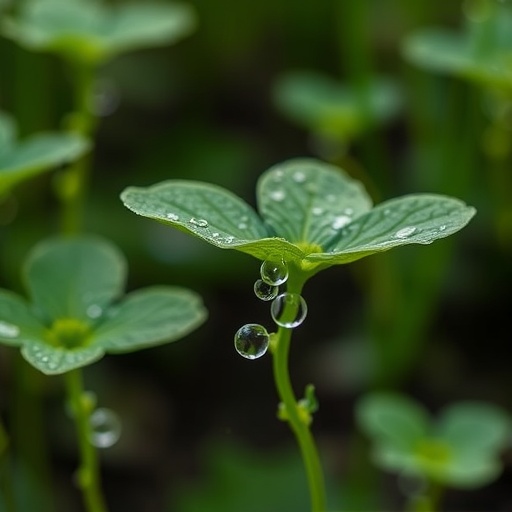In a groundbreaking study that pushes the boundaries of our understanding of plant biology and environmental interactions, researchers have unveiled a sophisticated mechanism by which plants detect and respond to organic pollutants. This discovery, recently published in Nature Communications, uncovers how plants utilize reactive oxygen species (ROS) as a signaling currency to propagate systemic acquired acclimation, leveraging their underground microbial communities—known as the rhizomicrobiota—to mount a coordinated defense response over long distances.
For decades, scientists have recognized that plants can sense and react to various stresses in their immediate environment, but the intricacies of how signals generated at one site within the plant communicate over vast internal distances remained elusive. This new research sheds light on the elusive communication highway connecting roots, shoots, and distant tissues, revealing a dynamic interplay involving ROS and the rhizosphere’s microbial inhabitants.
At the heart of the study lies the phenomenon that certain organic pollutants—ubiquitous contaminants resulting from industrial activity and agricultural runoff—can instigate an oxidative burst in specific root zones. This localized generation of ROS, molecules traditionally known for their damaging potential in cellular stress scenarios, paradoxically functions here as a systemic messenger. The research team employed advanced imaging techniques alongside molecular probes to trace ROS movement and signaling cascades, establishing that these molecules are not confined to the site of origin but rather orchestrate far-reaching defense acclimations.
What renders these findings particularly compelling is the dual role played by the rhizomicrobiota. Rather than being passive bystanders, these microbial communities embedded within the soil matrix actively facilitate the transmission and amplification of ROS signals. By modulating their own metabolic activities and secreting bioactive compounds, rhizomicrobes effectively participate in enhancing plant-wide resistance mechanisms, arguably forming a living extension of the plant’s immune system.
The implications of this signaling axis are profound. Systemic acquired acclimation, akin to a form of ‘immune memory’ in plants, allows them to preemptively bolster defenses in unexposed tissues, thus conferring heightened resilience to subsequent pollutant stresses. This holistic perspective on plant defense represents a paradigm shift, emphasizing the importance of inter-kingdom communications between plants and their subterranean microbial consortia.
Diving deeper into the molecular underpinnings, the study elucidates that ROS act as second messengers that activate a cascade of transcriptional responses, reprogramming gene expression profiles throughout the plant. This reprogramming instigates enhanced antioxidant enzyme activities and secondary metabolite production, equipping the plant to mitigate oxidative damage and restore cellular homeostasis. Strikingly, the presence and composition of rhizomicrobiota modulate the amplitude and duration of these responses, underscoring their regulatory influence over plant stress adaptation.
Experimental interventions involved manipulating pollutant concentrations and microbial community structures to dissect their respective contributions. Disrupting the rhizomicrobiota through sterilization or selective suppression resulted in attenuated systemic responses, reaffirming their indispensable role. Conversely, inoculation with specific beneficial microbes potentiated ROS signaling and systemic acclimation, hinting at prospective avenues for biotechnological applications in agriculture.
Perhaps one of the most fascinating aspects of this study is the spatial-temporal dynamics of ROS signaling. The movement of ROS from root to shoot is not instantaneous but occurs through a finely tuned relay system, possibly involving plasmodesmata and vascular tissues. This controlled propagation ensures signal fidelity and prevents untoward oxidative damage beyond the necessary signaling realm. The involvement of microbial partners adds a layer of complexity, as they may help sustain and refine this signal over time.
This discovery opens new vistas in understanding how environmental pollutants influence plant health beyond direct toxic effects. It positions the rhizosphere and its microbial inhabitants as crucial mediators in shaping plant responses to anthropogenic stressors. In the context of global environmental change and pollution, these insights could herald innovative strategies to enhance crop resilience, ecosystem stability, and sustainable agriculture.
Moreover, the revelation that plants can ‘communicate’ stress signals through ROS and microbial networks resonates with broader ecological themes. It challenges classical views of plants as passive entities and highlights their active engagement with the biotic and abiotic milieu. This intricate cross-talk epitomizes nature’s complexity wherein organisms collaborate at multiple levels to survive and thrive.
The methodology behind these findings involved an interdisciplinary approach, integrating plant physiology, microbiology, molecular biology, and environmental chemistry. Cutting-edge tools such as live-cell imaging, gene expression profiling, and microbiome sequencing were pivotal in untangling the intertwined interactions between plants, microbes, and pollutants.
Looking ahead, the research points to exciting questions about the specificity of ROS-mediated signaling in response to different classes of pollutants and environmental stresses. Additionally, understanding how rhizomicrobiota compositions vary across ecosystems and their influence on systemic acquired acclimation could provide critical insights for environmental management and restoration.
Furthermore, the potential to harness this natural defense mechanism offers promising prospects for developing bioinoculants or microbial consortia tailored to reinforce plant resilience. Such approaches could reduce reliance on chemical inputs and improve crop productivity under increasingly challenging conditions posed by pollution and climate change.
In sum, this illuminating study from Li, Zhang, and colleagues marks a milestone in plant science. It unveils a sophisticated communication network where organic pollutant-induced ROS signals travel long distances within plants, orchestrating systemic defenses with the indispensable cooperation of rhizomicrobiota. This discovery not only enriches fundamental biology but also sets the stage for translational advances aimed at sustainable agriculture and environmental health.
As our environment grows ever more complex and pressured by human activity, understanding and leveraging such intricate biological systems will be key to safeguarding plant ecosystems and the food security they underpin. The intertwining of ROS chemistry, microbial ecology, and plant systemic signaling thus represents a thriving frontier filled with promise for science and society alike.
Subject of Research: Plant systemic acquired acclimation mediated by reactive oxygen species signaling and rhizomicrobiota interaction induced by organic pollutants.
Article Title: Organic pollutant-induced long-distance ROS signaling drives plant systemic acquired acclimation via rhizomicrobiota.
Article References:
Li, Y., Zhang, K., Zhang, H. et al. Organic pollutant-induced long-distance ROS signaling drives plant systemic acquired acclimation via rhizomicrobiota. Nat Commun 16, 9077 (2025). https://doi.org/10.1038/s41467-025-64138-y
Image Credits: AI Generated




